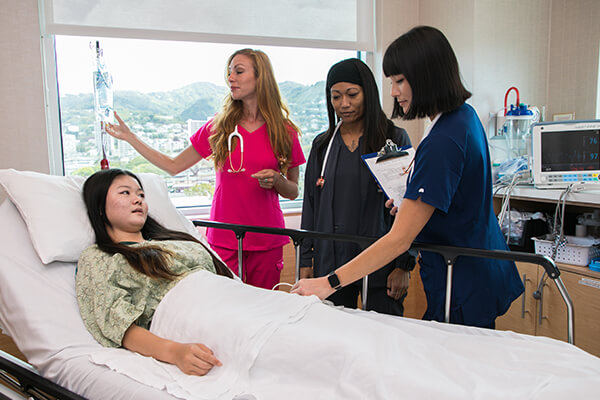10% of all employees in any area of work report some type of harassment or bullying. However, this is much higher in healthcare and rates among nurses are reported at almost 30%. Research has also shown that nurses spend 30-40% of their days dealing with harassment or relationship conflicts. These relationship conflicts lead to lower morale among nurses, worse patient outcomes, and high levels of nurse burnout.
A common trigger for these relationship conflicts are between units, most specifically between a “high acuity” unit, such as an intensive care unit (ICU) and a “low acuity” unit, such as a medical/surgical unit.
So, why is there so much animosity between nurses and between units? This is a hard question to answer, but going through the day to day life of each type of nurse is a start.
Day to Day Life of an ICU Nurse
An ICU nurse will typically work in an intensive care unit and can be further specialized into a surgical, medical, trauma, cardiac, or other type of ICU. These nurses will generally meet early for a safety huddle where they will also be given their assignments. Most ICU patient assignments will be one or two patients, and three at most in desperate situations.
Once the assignments are all distributed, each nurse will leave the briefing and head out onto the floor for report from the previous nurse. When working the day shift, you’ll receive report from the night shift nurse which includes primary medical history, this hospitalization overview, and what has taken place during that previous shift. All nurses have a different way of giving and receiving report as well as their own systems for writing it down on what’s called a “report sheet.”
Once report has been received, the day officially starts. This will vary drastically day to day but most nurses will log into the computer to write down orders like medications and labs and what times they’re due for the day. The morning is usually the busiest with med passes, provider rounds with new plans and new orders, and baths with linen changes. This continues into the afternoon much the same with the occasional emergency situation or procedure until 12 hours have gone by and the next shift starts all over again.
Day to Day Life of a Floor Nurse
A floor nurse can generally work in a variety of different places such as a medical surgical floor, the postpartum mother/baby floor, or a cardiac step down unit. While these range through the different specialties, they all have one thing in common: the acuity. While the intensive care units have high acuity patients, the floor units have low to moderate level acuity patients. Depending on the unit’s individual protocol, there may be a huddle in the morning similar to the flow of the ICU units. Otherwise, assignments will be posted in a central location and nurses will go directly to report from the previous nurses. This process is similar to that of the ICU nurses.
Floor nurses often have at least four to six patients and with the onset of COVID, this has been known to be as high as eight to 10. These patients are usually of moderate acuity, meaning that they are awake and not intubated, but still require regular monitoring and medication. The schedule and flow of the day is similar to the ICU on the floor just with more patients.
Similarities and Differences
While both units have a lot of similarities including the flow and reporting system, there are some important differences.
One major difference from the floor to the ICU is the assignment size. These smaller assignments in the ICU reflect the acuity and complexity of the patients. ICU patients are very often intubated, sedated, and very ill, requiring much more one-on-one attention from their nurse. It’s because of this that the assignments are generally smaller and where some of the animosity may start between the units. Since these patients are generally complex, ICU nurses do have more advanced skills with things like ventilators, code situations, and intravenous (IV) medications. However, floor nurses must balance a lot of different priorities with the number of patients they are responsible for during their shifts.
Another major difference can be specialties and range of knowledge. While a majority of ICUs will be separated by specialty, most floor units such as a medical surgical unit will not be. This makes it necessary for these nurses to have a wider knowledge base and skillset due to the wider variety of patients they see.
The Animosity: Where does it come from and how do we stop it?
There are many theories on why bullying and animosity occurs, most commonly a direct correlation to the stress of the work. Nurses work in high stress environments with internal and external stressors such as acuity of the patients, more chronic and complex diseases, and a lack of resources, support, or time off of work.
Three primary strategies have been identified to reduce bullying in healthcare: education, policy changes, and celebration. The most important step to overcoming a bullying culture is to teach nurses how to respond and how not to respond when confronted with a bully or bullying behavior. Education programs should include:
defining workplace bullying
any legal obligations
bullying prevention policies
bullying assessments
how to develop prevention measures
how to report bullying
how to investigate bullying
Once nurses have been educated, policies should be put in place to maintain this education. Nurses should also be involved in this policy development and it should involve respect, ensuring dignity, preventing discrimination, and be fair and just for all nurses. There should be equal opportunity and encouragement to demonstrate open communication and solve conflict creatively with positive attitudes.
With education and policies in place, all anti-bullying actions should be celebrated! Things like parties when policies are in effect, celebrating anti-bullying week, and any similar activities promote these behaviors and change the culture to one of mutual positive attitudes and respect.
References:
https://hospitalnews.com/a-hidden-truth-hostility-in-healthcare/
https://healthcare.utah.edu/the-scope/shows.php?shows=0_18b5tckc
Alison Shely, DNP, FNP-C
Alison Shely is a nurse practitioner, nurse coach, and nurse content writer who specializes in articles, guest blogger, and healthcare worker wellness. She has been in nursing since 2014, working in intensive care, women’s health, and primary care as a registered nurse and family nurse practitioner. She has written for a variety of publications including Rncareers.org and is also the winner of the 2020 Shift Report writing contest for Next Level Nursing. Her specialty topics include mental health, health and wellness, yoga philosophy and practice, and community health. She also serves as a health coach and mentor to other nurses and healthcare workers concerning healthy lifestyles and mental health.





